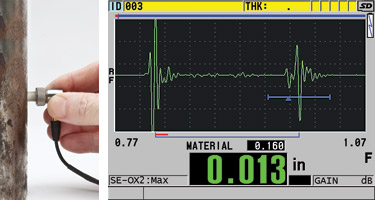Insitu Oxide Scale Thickness Measurement

Image - insitu-oxide-scale-thickness-measurement
- NDT Method
UT Thickness Gauging - Application Category
Boiler Inspection
The ID oxide scale is produced by oxidation in the reheater and superheater. The scale build up occurs when the tubes have experienced high temperatures for extended periods of time. The formation of ID scale reduces heat transfer and results in a further increase of tube metal temperature. Higher temperatures promote further growth of ID scale. The result is the ID scale feeds on itself and increases in thickness as it continues to grow.
The increase in ID scale and the associated tube metal temperature promotes creep in the tube metal. Formation of creep results in a loss of strength at high temperature and therefore a loss in remaining life. The final outcome of excessive scale is a thick lipped, long term overheat failure.
Ultrasonic technique
The ultrasonic method for measuring scale thickness is based on transmitting a wave through the tube thickness. The thickness is calculated by measuring the time difference between the signals reflected from the steel/scale interface and the tube ID surface. With advanced signal interprtation techniques, we can achieve Oxide scale Thickness measurements up to the resolution of 0.15 Microns.
At Vibrant NDT Services Pvt. Ltd. we use Advanced Ultrasonic Equipments and recommended accessories to perform Internal Oxide Scale Thickness measurements to ensure accuracy and repetability.
Theory
The very high temperatures found inside steam boilers (in excess of 1500 degrees Fahrenheit or 800 degrees Celsius) can cause the formation of a specific type of hard, brittle iron oxide called magnetite on the inside and outside surfaces of steel boiler tubing. At very high temperatures, water vapor will react with the iron in the steel to form magnetite and hydrogen.
The speed of this reaction increases with temperature. Oxygen atoms will diffuse inward through the magnetite layer, and iron atoms will diffuse outward, so the scale continues to grow even after the tube surface is completely covered.
Magnetite scale acts as thermal insulation on the pipe, since the thermal conductivity of scale is only about 5% that of steel. When heat can no longer transfer efficiently from the flame through the tube into the steam inside, the tube wall will heat up to temperatures beyond the intended operating range. Long term exposure to overly high temperatures, combined with the very high pressure inside the tube, leads to intergranular micro-cracking in the metal and to creep deformation (a slow swelling or bulging of the metal), which in turn eventually leads to tube failure by bursting.
A secondary issue is oxide exfoliation, in which pieces of oxide scale break off (usually due to thermal stresses during boiler startup or shutdown). These hard pieces will be carried by the steam flow into the turbine, where over time they will cause erosion damage.
The growth of magnetite scale and the associated metal damage are primary limiting factors with respect to boiler tube service life. The process begins slowly and then accelerates, for as the scale grows thicker the tube wall becomes hotter, and that in turn increases the rate of both scale growth and metal damage. Studies in the power generation industry have indicated that the effect of scale is relatively insignificant up to thicknesses of approximately 0.012 in. or 0.3 mm, but that beyond that thickness the negative effects of scale increase rapidly. Periodic measurement of scale thickness allows a plant operator to estimate remaining tube service life and to identify and replace tubes that are approaching the failure point. Ultrasonic testing provides a quick and nondestructive method for measuring scale. In all cases the coupling surface must be smooth and in some cases surface preparation will be required.
Articles related to Boiler Inspection
Talk to us Now !
We offer the best and most affordable NDT services in the market.
